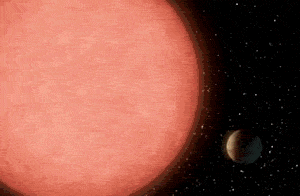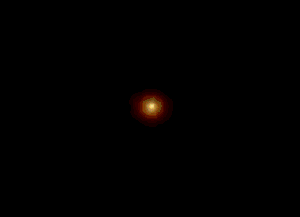Birth of planets
The explosive death of a massive star, known as a supernova, as shown on the right, is the birth of planets and solar systems. Energy released during a supernova equates to the amount of energy given off by our Sun during its 10 billion year life. Such an event was captured on 5th of APril 2006 happening 13,000 light years away by NASA's Switzer Space Telescope using its infrared sensors. Astronomers believe that planets might form from the ashes of these dead stars.
The animation on the right shows a red giant, about 15 times more massive and 40 times wider than our own Sun.
When the star runs out of nuclear fuel, it collapses and ultimately blows apart in what is called a supernova. Any nearby planet would be instantly incinerated.
All that remains of the dead star is its shrunken corpse, called a neutron star. Neutron stars are incredibly dense, with masses nearly one and a half times that of our Sun squeezed into bodies roughly 16 kilometres wide.
They are so dense that their gravity causes light to bend and warp around them. Just to give an example of its density, one teaspoon of a neutron star would weigh about 2 billion tons. The particular neutron star depicted here, called a pulsar, spins and pulses with X-ray radiation.

Debris from the supernova, that did not have sufficient velocity to escape the gravitational pull, settle into a disk orbiting around the pulsar, and can be thought of as falling back toward the star. This results in the formation of protoplanetary disks around young stars, out of which planets are thought to form.
Planets that form in this disk around the pulsar are bathed in radiation and inhospitable. Life could not evolve on such planets.

Our own solar system is thought to have originated from the remains of a similar supernova. Explosions are common in the life of our universe and give rise to everything within it.

The Big Bang is thought to have created all that is present in our universe and yet of all the 88 naturally occurring elements only hydrogen was produced. Abundant elements like iron and silicon, deep in the core of the Earth, had to come from somewhere else.
These elements came from stars like our own Sun. Inside such stars hydrogen is fused to make heavier elements up to iron. Elements heavier than iron are created when these stars die and explode in supernovae. The energy to fuse atomic nuclei heavier than iron together is so great that it is only available during a supernova.
Hence elements such as uranium, lead and gold, found here on Earth, were formed in a supernova.

Indicate True or False
a) Hydrogen is produced in our Sun
b) Uranium is a product of the Big Bang
c) Large stars explode only when they have too much fuel.
d) A supernova is a large galaxy.
e) Hydrogen was the first element formed after the Big Bang
f). All the known elements are continuously forming from vacuum energy deep in space
g) Hydrogen is currently being formed in the cores of large stars
Explain your answer to the true/false questions above